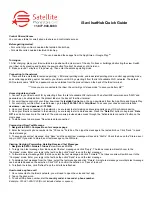
4
Case II:
Split Flexible Configurations Conference Room
Factor
4 Antennas on Ceiling
Equal
Distance
The RF Signal of transmitters close to the receiver antennas can lower the sensitivity of the receiver so that transmitters
that are farther away do not have an adequate signal level at the receiver. Also using transmitters too close to the
receiver antennas or at too high of transmit power can cause Intermodulation Distortion which can either shadow desired
transmitter signals, or cause distortion in the receiver. All of the transmitters are about the same distance to the closest
antenna. It meets the design rule.
Diversity
The antennas are separated so at least one antenna is always out of the transmitter antenna’s null. Having two antennas
reduces the chance of an antenna failure causing a complete loss of signal (redundancy) and having distance between
the antennas (space diversity) means that the normal variations in signal strength caused by the transmitter signals
interacting with the environment will be covered by the overlapping receiver antenna patterns. This meets the design rule.
Line of Sight
All transmitters are in the line of sight of both antennas. It meets the design rule.
Cable Loss
Antenna combiners add 3 dB loss. Make sure the total loss in each run is less than 15 dB to meet the design rule.
Range Loss
All transmitters are close to at least one antenna and have about the same gain. This meets the design rule.
Transmitter
Power
The setup is ideal, so set the power to 1mW for extended battery life and minimal interference with systems in near-by rooms.
Rating
Expect excellent performance when the divider wall is open or closed.
Factor
2 Antennas on Back (or Front) Wall
Equal
Distance
The RF Signal of transmitters close to the receiver antennas can lower the sensitivity of the receiver so that transmitters
that are farther away do not have an adequate signal level at the receiver. Also using transmitters too close to the receiver
antennas or at too high of transmit power can cause Intermodulation Distortion which can either shadow desired transmit-
ter signals, or cause distortion in the receiver. Expect dropouts and hits with large numbers of transmitters. Diversity
Dividers often have metal cores which block wireless microphone signals. Diversity is defeated when there is only one
antenna in a room. Expect dropouts and hits when the room is divided.
Diversity
Dividers often have metal cores which are radio opaque. Diversity is defeated when there is only one antenna in a room.
Expect dropout and hits when the room is divided.
Line of Sight
No transmitter is in the line of sight of both antennas when the room is divided. It does not meet the design criterion.
Cable Loss
Long cable runs require expensive low-loss cable. Make sure the loss on each side is less than 15 dB.
Range Loss
Use low-loss cable for long runs. Make sure the loss on each side is less than 15 dB.
Transmitter
Power
Use 10 mW output power to assure pick-up of the far transmitters.
Rating
This system is prone to dropouts and hits open or closed.
1st Choice
B.
Not Recommended
A.






























